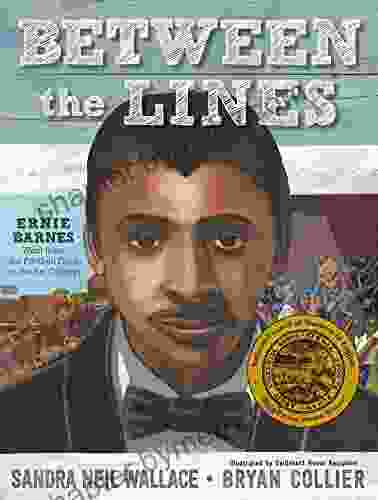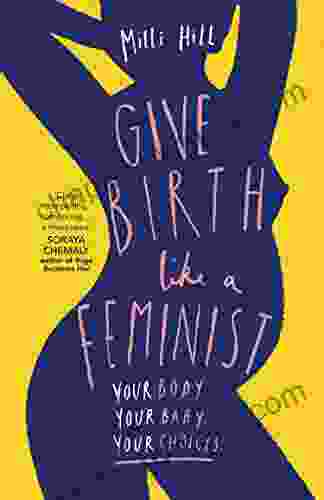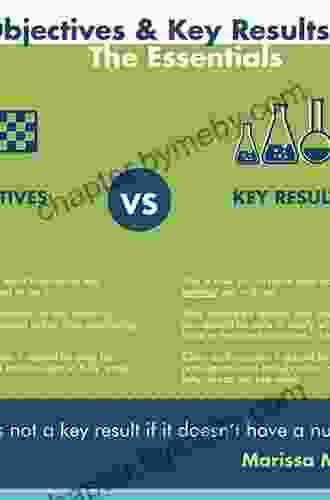Objectives and Key Results: The Ultimate Guide to Setting Strategic Goals

In today's fast-paced and competitive business environment, it's crucial to have a clear roadmap for success. Objectives and Key Results (OKRs) provide a powerful framework for setting strategic goals that align your organization's aspirations with actual performance.
4.6 out of 5
| Language | : | English |
| File size | : | 7026 KB |
| Text-to-Speech | : | Enabled |
| Screen Reader | : | Supported |
| Enhanced typesetting | : | Enabled |
| Word Wise | : | Enabled |
| Print length | : | 211 pages |
| Lending | : | Enabled |
This comprehensive guide will delve into the world of OKRs, empowering you with the knowledge and tools to effectively use this transformative methodology. From understanding the fundamentals to practical implementation, you'll gain invaluable insights into how OKRs can drive growth and success across all levels of your organization.
Understanding the OKR Framework
OKRs consist of two key components:
- Objective: A qualitative statement that defines the desired outcome you aim to achieve within a specific timeframe.
- Key Result: A quantifiable measure that tracks your progress towards the objective. Key Results should be specific, measurable, achievable, relevant, and time-bound (SMART).
Benefits of Using OKRs
Implementing OKRs offers numerous advantages for organizations:
- Clarity and Focus: OKRs provide a clear understanding of what needs to be achieved and how to measure success.
- Alignment and Engagement: By aligning OKRs across the organization, you ensure that all team members are working towards the same goals.
- Transparency and Accountability: OKRs foster transparency and accountability by making goals visible to all stakeholders.
- Agility and Adaptability: OKRs are designed to be flexible and adaptable, allowing organizations to adjust quickly to changing priorities.
- Continuous Improvement: OKRs drive continuous improvement by providing a structured framework for tracking and evaluating progress.
Setting Effective OKRs
To set effective OKRs, follow these steps:
- Define Clear and Ambitious Objectives: Objectives should be challenging yet achievable, inspiring teams to strive for excellence.
- Identify Measurable Key Results: Key Results should quantify progress towards objectives, providing tangible evidence of success.
- Align OKRs Across Levels: Link team and individual OKRs to the overall organizational objectives, ensuring a cohesive and aligned approach.
- Establish Clear Timeframes: Set realistic timeframes for achieving OKRs, creating a sense of urgency and accountability.
- Review and Adjust Regularly: OKRs should be reviewed regularly, allowing for adjustments and optimizations based on progress and feedback.
Tracking and Evaluating OKRs
Effective OKR implementation requires consistent tracking and evaluation:
- Establish a Tracking System: Implement a system to monitor progress towards Key Results, providing real-time insights into performance.
- Conduct Regular Reviews: Schedule periodic reviews to assess progress, identify challenges, and make necessary adjustments.
- Provide Feedback and Coaching: Offer constructive feedback and coaching to support teams and individuals in achieving their OKRs.
- Celebrate Success: Recognize and celebrate achievements to motivate and engage the team.
Case Studies and Best Practices
Numerous organizations have successfully implemented OKRs to drive growth and innovation. Here are some notable examples:
- Google: Pioneered the use of OKRs to align its massive workforce and achieve ambitious goals.
- Intel: Used OKRs to drive a culture of innovation and continuous improvement.
- Adobe: Implemented OKRs to enhance collaboration and foster a growth mindset across the organization.
Objectives and Key Results are an indispensable tool for organizations seeking to set strategic goals, align teams, and drive performance. By embracing the OKR framework, you can unlock the potential for growth, innovation, and sustainable success. This comprehensive guide has provided you with the knowledge and insights to effectively implement OKRs in your organization. Embrace the transformative power of OKRs and witness the extraordinary results they can deliver.
4.6 out of 5
| Language | : | English |
| File size | : | 7026 KB |
| Text-to-Speech | : | Enabled |
| Screen Reader | : | Supported |
| Enhanced typesetting | : | Enabled |
| Word Wise | : | Enabled |
| Print length | : | 211 pages |
| Lending | : | Enabled |
Do you want to contribute by writing guest posts on this blog?
Please contact us and send us a resume of previous articles that you have written.
 Book
Book Novel
Novel Page
Page Chapter
Chapter Text
Text Story
Story Genre
Genre Reader
Reader Library
Library Paperback
Paperback E-book
E-book Magazine
Magazine Newspaper
Newspaper Paragraph
Paragraph Sentence
Sentence Bookmark
Bookmark Shelf
Shelf Glossary
Glossary Bibliography
Bibliography Foreword
Foreword Preface
Preface Synopsis
Synopsis Annotation
Annotation Footnote
Footnote Manuscript
Manuscript Scroll
Scroll Codex
Codex Tome
Tome Bestseller
Bestseller Classics
Classics Library card
Library card Narrative
Narrative Biography
Biography Autobiography
Autobiography Memoir
Memoir Reference
Reference Encyclopedia
Encyclopedia Tjio Kayloe
Tjio Kayloe Matti Charlton
Matti Charlton Richard Connell
Richard Connell Paul Orlousky
Paul Orlousky Mary Reynolds
Mary Reynolds Matt Titus
Matt Titus Mila Finley
Mila Finley Will Harlan
Will Harlan Micki Savin
Micki Savin Michael Fry
Michael Fry Mathew Orton
Mathew Orton Martha Bayne
Martha Bayne Mickie Kennedy
Mickie Kennedy Michael T Kaufman
Michael T Kaufman Martin Johnson
Martin Johnson Martha Wells
Martha Wells Paul Fleischman
Paul Fleischman Tiara Mcclure
Tiara Mcclure Shaun Chamberlin
Shaun Chamberlin Michael Brooke
Michael Brooke
Light bulbAdvertise smarter! Our strategic ad space ensures maximum exposure. Reserve your spot today!

 Herman MelvilleUnveiling Ernie Barnes' Extraordinary Journey: From the Gridiron to the...
Herman MelvilleUnveiling Ernie Barnes' Extraordinary Journey: From the Gridiron to the... Michael SimmonsFollow ·19.8k
Michael SimmonsFollow ·19.8k Aleksandr PushkinFollow ·12k
Aleksandr PushkinFollow ·12k Hank MitchellFollow ·4k
Hank MitchellFollow ·4k Salman RushdieFollow ·13.8k
Salman RushdieFollow ·13.8k Hugh ReedFollow ·18k
Hugh ReedFollow ·18k Tyrone PowellFollow ·7.6k
Tyrone PowellFollow ·7.6k Travis FosterFollow ·2.3k
Travis FosterFollow ·2.3k W. Somerset MaughamFollow ·11.3k
W. Somerset MaughamFollow ·11.3k

 Henry James
Henry JamesCold War Fighter Pilot Story: A Captivating Tale of...
Enter the Cockpit of...

 Rudyard Kipling
Rudyard KiplingYour Body Your Baby Your Choices: The Essential Guide to...
Pregnancy and...

 Fabian Mitchell
Fabian MitchellMichelle Obama: An Intimate Portrait - A Must-Read for...
Michelle Obama is a prominent figure in...

 Juan Butler
Juan ButlerUncover the Secrets of the Dead Land Warshawski Novels
Prepare to delve...
4.6 out of 5
| Language | : | English |
| File size | : | 7026 KB |
| Text-to-Speech | : | Enabled |
| Screen Reader | : | Supported |
| Enhanced typesetting | : | Enabled |
| Word Wise | : | Enabled |
| Print length | : | 211 pages |
| Lending | : | Enabled |













